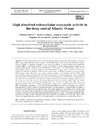Please use this identifier to cite or link to this item:
https://accedacris.ulpgc.es/jspui/handle/10553/51639
| Title: | High dissolved extracellular enzymatic activity in the deep central Atlantic ocean | Authors: | Baltar, Federico Aristegui, Javier Gasol, Josep M. Sintes, Eva Van Aken, Hendrik M. Herndl, Gerhard J. |
UNESCO Clasification: | 251001 Oceanografía biológica | Keywords: | Dissolved extracellular enzymatic activity Prokaryotic heterotrophic production Particulate organic matter Deep ocean |
Issue Date: | 2010 | Publisher: | 0948-3055 | Journal: | Aquatic Microbial Ecology | Abstract: | The distribution of prokaryotic abundance (PA), prokaryotic heterotrophic production (PHP), and suspended particulate organic material (POM), as well as total and dissolved (operationally defined as passing through 0.2 µm pore size filters) potential extracellular enzymatic activities (EEA; α- and β-glucosidase [AGase and BGase], leucine aminopeptidase [LAPase], and alkaline phosphatase [APase]) were determined in the meso- and bathypelagic waters of the (sub)tropical Atlantic along an eastern zonal transatlantic transect and a western N-S transect. Significant differences between both transects were found for POM concentration but not for PA, PHP (except in the subsurface and oxygen minimum layer), and dissolved and total EEA. PHP decreased by 3 orders of magnitude from the lower euphotic zone to bathypelagic waters, while PA and cell-specific PHP decreased only by 1 and 2 orders of magnitude, respectively. The proportion of the dissolved to the total EEA was high in the dark ocean for all the enzymes, ranging from 54 to 100, 56 to 100, 65 to 100 and 57 to 97% for AGase, BGase, LAPase and APase, respectively. The kinetic parameters (Vmax and Km) of both the dissolved and total fractions of LAPase and APase were very similar throughout the water column, suggesting a similar origin for both dissolved and particulate EEA. Significant correlations of both dissolved and total EEA were found with prokaryotic metabolism and the POM pool. Based on the previous notion that the fraction of dissolved EEA is higher in particle-attached than in free-living microbes, our results suggest that microbial activity in the dark ocean occurs mainly on colloidal and particulate material. This is in agreement with recent genomic evidence. However, these colloidal and particulate materials are prone to disruption during the sampling process. Hence, more selective sampling techniques are needed to specifically collect these deep-water aggregates that probably represent hotspots of microbial activity in the deep ocean. | URI: | https://accedacris.ulpgc.es/handle/10553/51639 | ISSN: | 0948-3055 | DOI: | 10.3354/ame01377 | Source: | Aquatic Microbial Ecology [ISSN 0948-3055], v. 58 (3), p. 287-302 |
| Appears in Collections: | Artículos |
Items in accedaCRIS are protected by copyright, with all rights reserved, unless otherwise indicated.
